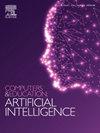A cross-national assessment of artificial intelligence (AI) Chatbot user perceptions in collegiate physics education
Q1 Social Sciences
Computers and Education Artificial Intelligence
Pub Date : 2025-01-10
DOI:10.1016/j.caeai.2025.100365
引用次数: 0
Abstract
This study explores the perception of artificial intelligence (AI)-based Chatbots, specifically Open AI's ChatGPT use, among physics students in four universities in Ghana, Jordan, and the United States. We utilized a survey instrument adapted from the Technology Acceptance Model (TAM) to elicit responses from 804 students. TAM constructs: Perceived Usefulness (PU), Perceived Ease of Use (PEU), Subjective Norms (SN), Attitude Towards Technology Use (ATU), Behavioral Intention (BI), and User Behavior (UB) were assessed. We also assessed perceptions of ethical use (EU) and student learning outcomes (SLO) using a Structural Equation Model (SEM) approach. A measurement model had good fit indices and validated most hypotheses. A path analysis (PA) for hypothesized relationships suggested PEU and SN are significant predictors of BI and UB, whereas PU's influence on BI was indirect. Significantly, EU concerns negatively moderated the relationship between BI and UB, suggesting that higher ethical concerns can reduce ChatGPT usage. Cross-cultural analysis uncovered significant differences in perceptions and usage patterns influenced by institutional policies, academic levels, and demographic factors. Our findings affirm TAM's robustness in predicting technology use across various cultural and institutional settings. Findings also underscore the crucial roles of social influence in fostering positive user behaviors for Chat GPT. This study provides insights for educators and policymakers to develop strategies for integrating AI Chatbots responsibly and effectively in collegiate physics education while addressing ethical concerns. A longitudinal survey of the relationships between consistent AI Chatbot use, institutional support, student motivation, and learning outcomes is recommended.
求助全文
约1分钟内获得全文
求助全文
来源期刊

Computers and Education Artificial Intelligence
Social Sciences-Education
CiteScore
16.80
自引率
0.00%
发文量
66
审稿时长
50 days
 求助内容:
求助内容: 应助结果提醒方式:
应助结果提醒方式:


